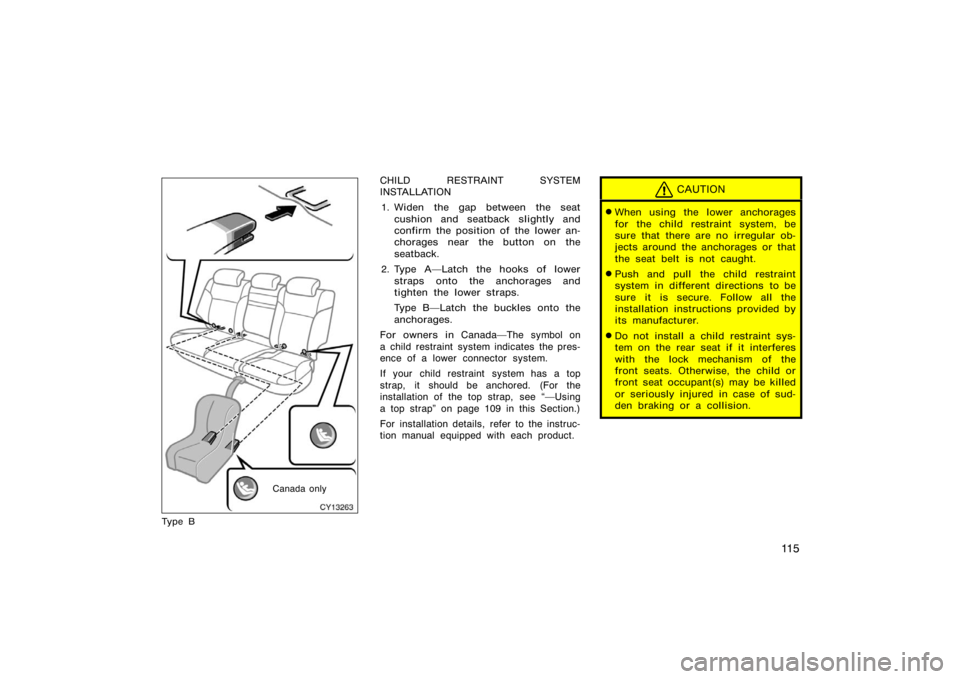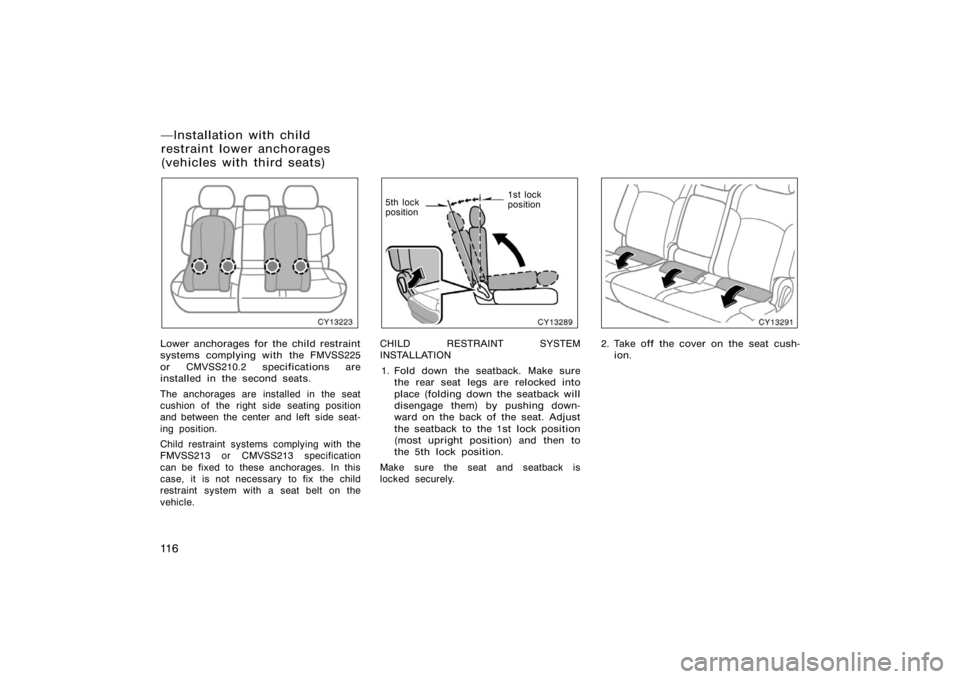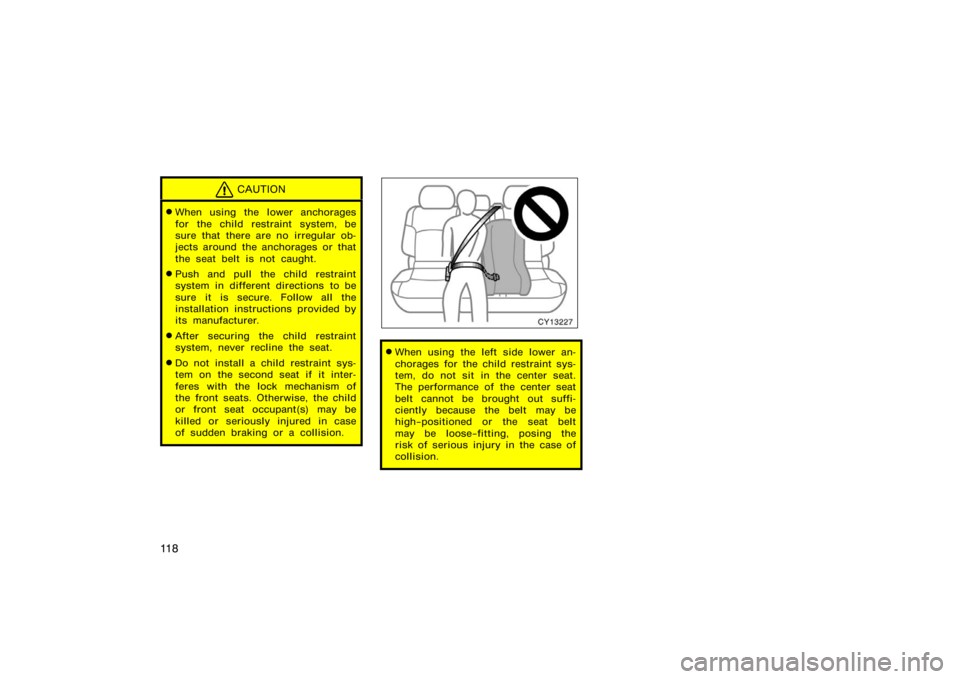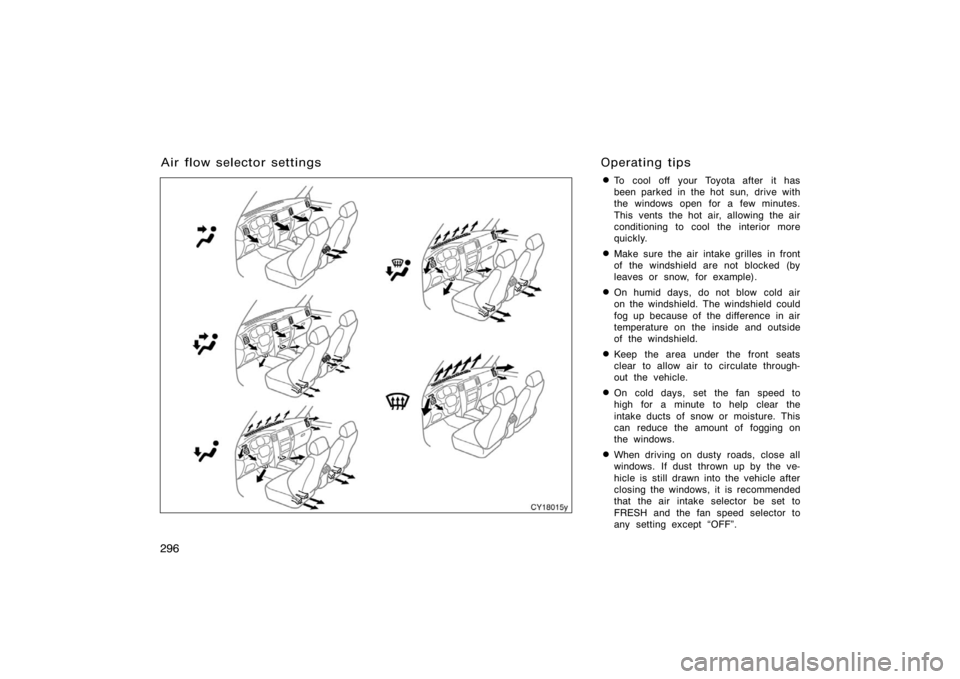Page 127 of 496

11 5
CY13263
Canada only
Ty p e B
CHILD RESTRAINT SYSTEM
INSTALLATION1. Widen the gap between the seat cushion and seatback slightly and
confirm the position of the lower an-
chorages near the button on the
seatback.
2. Type A�Latch the hooks of lower straps onto the anchorages and
tighten the lower straps.
Type B�Latch the buckles onto the
anchorages.
For owners in Canada� The symbol on
a child restraint system indicates the pres-
ence of a lower connector system.
If your child restraint system has a top
strap, it should be anchored. (For the
installation of the top strap, see ��Using
a top strap" on page 109 in this Section.)
For installation details, refer to the instruc-
tion manual equipped with each product.CAUTION
�When using the lower anchorages
for the child restraint system, be
sure that there are no irregular ob-
jects around the anchorages or that
the seat belt is not caught.
�Push and pull the child restraint
system in different directions to be
sure it is secure. Follow all the
installation instructions provided by
its manufacturer.
�Do not install a child restraint sys-
tem on the rear seat if it interferes
with the lock mechanism of the
front seats. Otherwise, the child or
front seat occupant(s) may be killed
or seriously injured in case of sud-
den braking or a collision.
Page 128 of 496

11 6
CY13223
Lower anchorages for the child restraint
systems complying with the FMVSS225
or CMVSS210.2 specifications are
installed in the second seats.
The anchorages are installed in the seat
cushion of the right side seating position
and between the center and left side seat-
ing position.
Child restraint systems complying with the
FMVSS213 or CMVSS213 specification
can be fixed to these anchorages. In this
case, it is not necessary to fix the child
restraint system with a seat belt on the
vehicle.
CY13289
1st lock
position
5th lock
position
CHILD RESTRAINT SYSTEM
INSTALLATION
1. Fold down the seatback. Make sure the rear seat legs are relocked into
place (folding down the seatback will
disengage them) by pushing down-
ward on the back of the seat. Adjust
the seatback to the 1st lock position
(most upright position) and then to
the 5th lock position.
Make sure the seat and seatback is
locked securely.
CY13291
2. Take off the cover on the seat cush- ion.
�Installation with child
restraint lower anchorages
(vehicles with third seats)
Page 130 of 496

11 8
CAUTION
�When using the lower anchorages
for the child restraint system, be
sure that there are no irregular ob-
jects around the anchorages or that
the seat belt is not caught.
�Push and pull the child restraint
system in different directions to be
sure it is secure. Follow all the
installation instructions provided by
its manufacturer.
�After securing the child restraint
system, never recline the seat.
�Do not install a child restraint sys-
tem on the second seat if it inter-
feres with the lock mechanism of
the front seats. Otherwise, the child
or front seat occupant(s) may be
killed or seriously injured in case
of sudden braking or a collision.
CY13227
�When using the left side lower an-
chorages for the child restraint sys-
tem, do not sit in the center seat.
The performance of the center seat
belt cannot be brought out suffi-
ciently because the belt may be
high−positioned or the seat belt
may be loose−fitting, posing the
risk of serious injury in the case of
collision.
Page 308 of 496

296�
To cool off your Toyota after it has
been parked in the hot sun, drive with
the windows open for a few minutes.
This vents the hot air, allowing the air
conditioning to cool the interior more
quickly.
�Make sure the air intake grilles in front
of the windshield are not blocked (by
leaves or snow, for example).
�On humid days, do not blow cold air
on the windshield. The windshield could
fog up because of the difference in air
temperature on the inside and outside
of the windshield.
�Keep the area under the front seats
clear to allow air to circulate through-
out the vehicle.
�On cold days, set the fan speed to
high for a minute to help clear the
intake ducts of snow or moisture. This
can reduce the amount of fogging on
the windows.
�When driving on dusty roads, close all
windows. If dust thrown up by the ve-
hicle is still drawn into the vehicle after
closing the windows, it is recommended
that the air intake selector be set to
FRESH and the fan speed selector to
any setting except �OFF".
Air flow selector settings
CY18015y
Operating tips
Page 340 of 496
328
The cup holders are designed for hold-
ing cups or drink−cans securely.
The cup holder can be adjustable to the
size of the cups or drink−cans by
changing the holder position and the
arm position, as shown.
With the instrument panel lights on, the
front cup holder position indicator lights
will come on.
CAUTION
Do not place anything else other than
cups or drink−cans in the cup holder,
as such items may be thrown about
in the compartment and possibly in-
jured people in the vehicle during
sudden braking or in an accident.
CY19075
The rear cup holders and tray are
housed in the armrest.
The cup holders are designed to hold
cups or beverage cans securely.1. To use the rear cup holders and tray, pull the armrest out.CY19100
Rear cup holders and tray
(vehicles without third seats)
Page 342 of 496
330
CY19114
Type A (armrest)
CY19113
Type B (rear tire house)
The cup holders are designed for hold-
ing cups or drink−cans securely.
Type A�To use the holder, pull the arm-
rest out and push the lid.
CAUTION
�Do not place anything else other
than cups or drink−cans in the cup
holder, as such items may be
thrown about in the compartment
and possibly injure people in the
vehicle during sudden braking or in
an accident.
�Type A�To reduce the chance of
injury in case of an accident or
sudden stop while driving, keep the
cup holder closed when it is not in
use.
CY19015
Front doors
CY19016
Rear doors
Rear cup holders
(vehicles with third seats)Bottle holders
Page 369 of 496

357
Ti r e relat ed ter m
Meaning
Cold tire inflation pressure
tire inflation pressure when the vehicle has been parked for at least 3 hours
or more, or it has not been driven more than 1.5 km or 1 mile under that
condition
Maximum inflation pressurethe maximum cold inflation
pressure to which a tire may be inflated and it is
shown on the sidewall of the tire
Recommended inflation pressurecold tire inflation pressure recommended by a manufacturer
Accessory weight
the combined weight (in excess of those standard items which may be replaced)
of automatic transmission, power steering, power brakes, power windows, pow-
er seats, radio, and heater, to the extent that these items are available as
factory−installed equipment (whether installed or not)
Curb weight
the weight of a motor vehicle with standard equipment including the maximum
capacity of fuel, oil, and coolant, and, if so equipped, air conditioning and addi-
tional weight optional engine
Maximum loaded vehicle weight
the sum of�
(a) curb weight;
(b) accessory weight;
(c) vehicle capacity weight; and
(d) production options weight
Normal occupant weight68 kg (150 lb.) times the number of occupants specified in the second column
of Table 1 that follows
�Glossary of tire terminology
Page 376 of 496

364 Vehicle load limits include total load
capacity, seating capacity, towing ca-
pacity and cargo capacity. Follow the
load limits shown below. Total load ca-
pacity and seating capacity are also
described on the tire and loading in-
formation label. For location of the tire
and loading information label, see
�Checking tire inflat ion pr es s ur e" on
page 441.
Total load capacity:
With 5 occupants:431 kg (950 lb.)
With 7 occupants: 477 kg (1050 lb.)
Total load capacity means com-
bined weight of occupants, cargo
and luggage. Tongue load is in-
cluded when trailer towing. Seating capacity:
Without third seats:Total 5 (Front 2, Rear 3)
With third seats: Total 7 (Front 2, Rear 5)
Seating capacity means the maxi-
mum number of occupants whose
estimated average weight is 68 kg
(150 lb.) per person. Depending on
the weight of each person, the seat-
ing capacity given may exceed the
total load capacity.
NOTICE
Even if the number of occu-
pants are within the seating ca-
pacity, do not exceed the total
load capacity.
Towing capacity:For weight carrying hitch2268 kg (5000 lb.)
Also for weight distributing hitch
(4.7 L V8 [2UZ−FE] engine only) Two−wheel drive models3311 kg (7300 lb.)
Four−wheel drive models 3175 kg (7000 lb.)
Towing capacity means the maxi-
mum gross trailer weight (trailer
weight plus its cargo weight) that
your vehicle is able to tow.
Veh icle lo ad lim it s